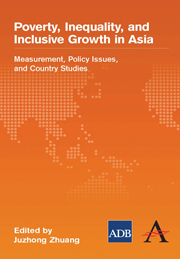Book contents
- Frontmatter
- Contents
- Foreword
- Preface and Acknowledgments
- Contributors
- Abbreviations, Acronyms, and Symbols
- Tables, Figures, and Boxes
- 1 Poverty, Inequality, and Inclusive Growth in Asia
- Part A Measuring Inequality and Poverty
- Part B Selected Policy Issues for Inclusive Growth
- Part C Country Studies
- 9 Growth, Inequality, and the Labor Market: The Philippines
- 10 Poverty and Inequality in Nepal: An Empirical Analysis
- 11 Decomposing Income Inequality: People's Republic of China, 1990–2005
- 12 Evolution of Income Mobility: People's Republic of China, 1991–2002
- 13 Occupational Segregation and Gender Discrimination in Labor Markets: Thailand and Viet Nam
- 14 Inclusiveness through Food Security: The Philippines' National Food Program
- Index
11 - Decomposing Income Inequality: People's Republic of China, 1990–2005
from Part C - Country Studies
Published online by Cambridge University Press: 05 March 2012
- Frontmatter
- Contents
- Foreword
- Preface and Acknowledgments
- Contributors
- Abbreviations, Acronyms, and Symbols
- Tables, Figures, and Boxes
- 1 Poverty, Inequality, and Inclusive Growth in Asia
- Part A Measuring Inequality and Poverty
- Part B Selected Policy Issues for Inclusive Growth
- Part C Country Studies
- 9 Growth, Inequality, and the Labor Market: The Philippines
- 10 Poverty and Inequality in Nepal: An Empirical Analysis
- 11 Decomposing Income Inequality: People's Republic of China, 1990–2005
- 12 Evolution of Income Mobility: People's Republic of China, 1991–2002
- 13 Occupational Segregation and Gender Discrimination in Labor Markets: Thailand and Viet Nam
- 14 Inclusiveness through Food Security: The Philippines' National Food Program
- Index
Summary
Introduction
Rapid growth in the People's Republic of China (PRC), which began as it embarked on economic reforms in the late 1970s, has been accompanied by rising income inequality. During 1985–2006, the country's real per capita gross domestic product grew at an annual average rate of 8.5%. Such strong growth led to an unprecedented reduction in the incidence of poverty, from 32.5% in 1990 to 7.1% in 2005, measured by the $1-a-day international poverty line (Ali and Zhuang 2007). However, the Gini coefficient of per capita income also increased, from about 0.30 in the early 1980s to about 0.45 in 2001 at the national level (Ravallion and Chen 2007).
The literature on income inequality in the PRC is extensive. Researchers have used three types of data: unit-level household survey data, aggregate income data, and grouped household survey data. Due to the absence of consistent data covering the entire PRC, studies based on unit-level data often focus on a particular segment of the population, such as urban households (Cao and Nee 2005, Meng 2004) or rural households (Gustafsson and Li 2002), for isolated years. Aggregate data, often at the provincial level, have been used to investigate the spatial dimension of inequality (Hussain and Zhuang 1994, Kanbur and Zhang 2005).
More recently, attempts have been made to study the PRC's income inequality by extrapolating unit-level data from grouped household income data. Notable examples are Ravallion and Chen (2007) and Chotikapanich et al. (2007).
- Type
- Chapter
- Information
- Poverty, Inequality, and Inclusive Growth in AsiaMeasurement, Policy Issues, and Country Studies, pp. 367 - 386Publisher: Anthem PressPrint publication year: 2010
- 4
- Cited by



